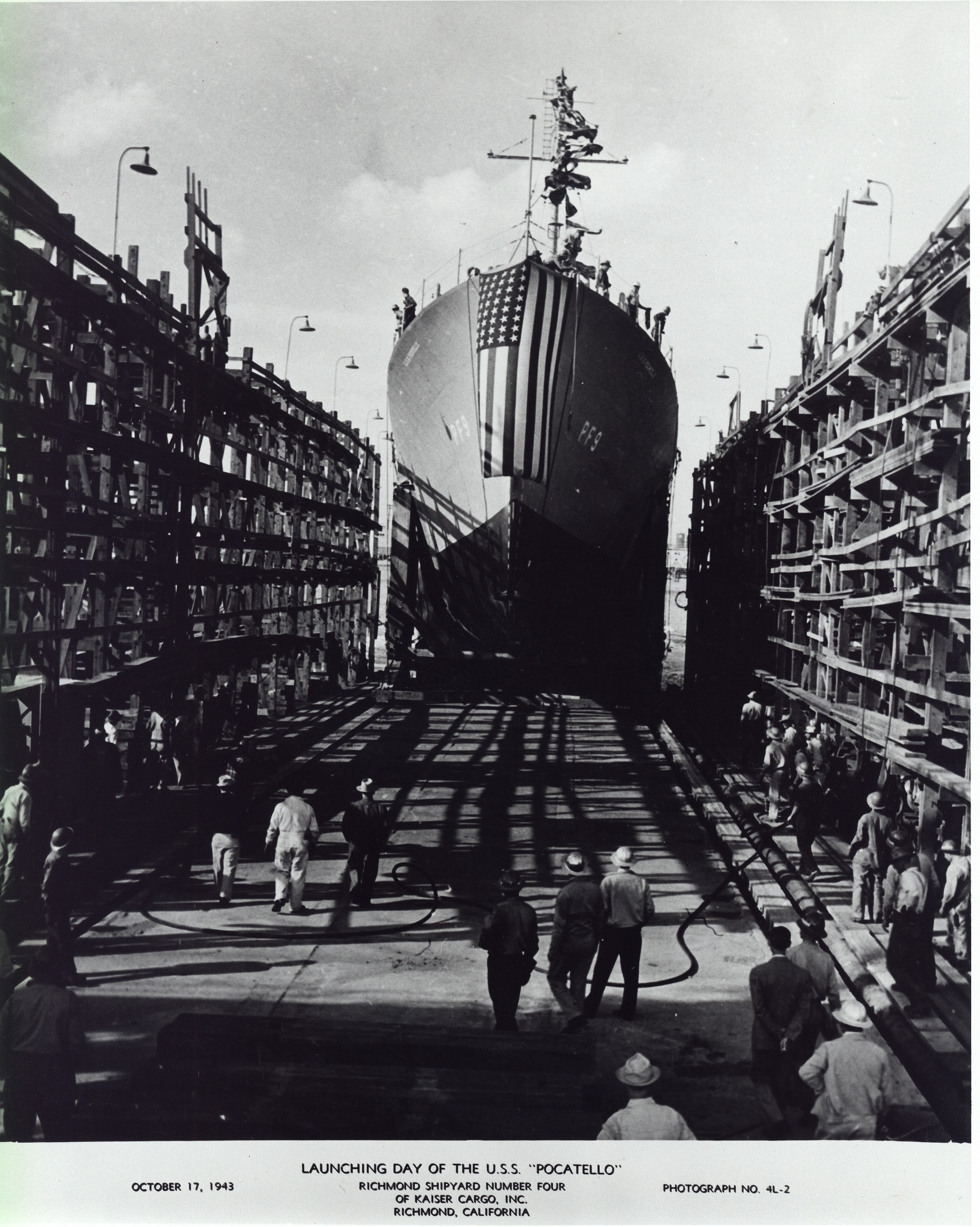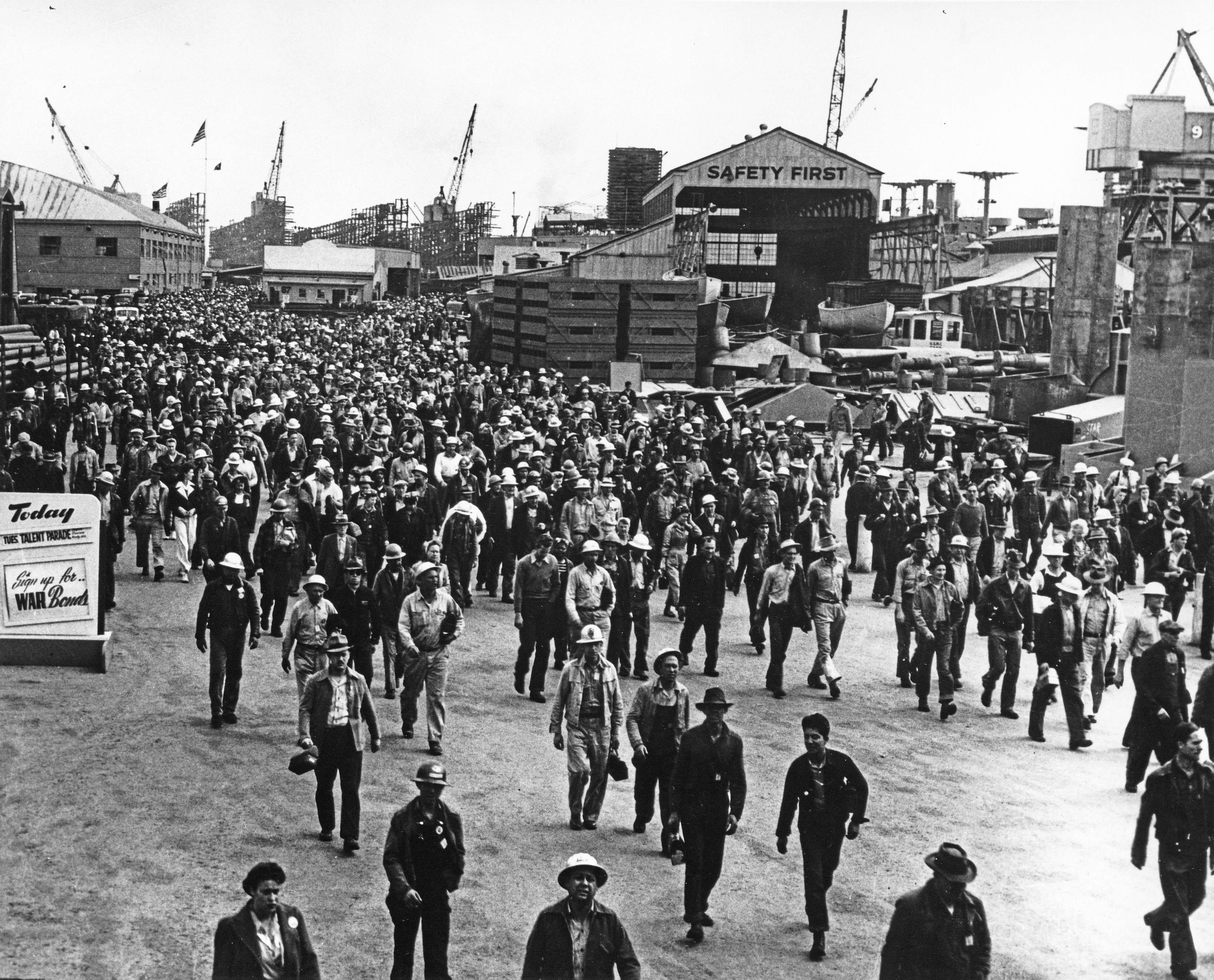This profile is the sixth in our series Beyond the Forest, which examines the lives and careers of UC Santa Cruz grads who have found their own paths using the humanities as their foundation.
On a sunny afternoon the view is impressive from the 19th floor of the Ordway Building at 1 Kaiser Plaza in Oakland CA — whether looking South over shimmering Lake Merritt, East to the brown Oakland hills dotted with homes, or West towards the blue San Francisco Bay, reflecting the sunlight.
A more interesting view may be found inside the headquarters of Kaiser Permanente, the nation’s largest nonprofit managed care organization, where the walls are lined with black and white photographs — not of hospitals, but of shipyards, including those in nearby Richmond, CA, where the Kaiser shipbuilding company built 747 transport ships during World War II. These were the Liberty Ships that carried vast numbers of troops and supplies to Asia and Europe. In these shipyards, industrialist Henry J. Kaiser developed innovations that helped the nation build more ships, in much less time, at a quarter of the cost of what had been the norm.
One of the hundreds of Kaiser Liberty Ships launched from the shipyards in Richmond, CA, 1943. Used with the permission of Kaiser Permanente Heritage Resources.
Kaiser also used a novel workforce, and that’s what makes these photographs so compelling. It’s the people — workers during a change of shifts. Several things stand out: they are well dressed, focused, confident, and even joyful.
Look closer, and you notice that there are women in the crowd; prior to the war, women would not have been hired in such physically demanding roles. There are also African-Americans, mostly men who likewise would not have been hired into skilled manufacturing jobs before the war, but also women who served superbly as welders and in other demanding roles. These photographs are a stunning display of the social and economic transformation, through the engagement of a talented and dedicated workforce, that was needed for the massive effort required to win the war.
Workers at the Kaiser Shipyards in Richmond, CA, leaving their shift. Used with the permission of Kaiser Permanente Heritage Resources.
I’m here at the headquarters of Kaiser Permanente with Cari Napoles, Director of Development for the University of California, Santa Cruz Humanities Division, to meet Mark Zemelman, Senior Vice President and General Counsel, Kaiser Foundation Health Plan, Inc. and Kaiser Foundation Hospitals. Mark is a UC Santa Cruz alumnus and he graciously agreed to meet with us to discuss his time at UC Santa Cruz, the experiences he had and the values he developed there, and how they led him, eventually, to find his mission in health care.
Zemelman’s pursuits are a summary of some of the most important social and political movements of the last half century: civil rights, social diversity, environmental protection, and the provision of affordable high-quality healthcare. Mark used his education at UC Santa Cruz to explore these issues, forge a career, and make his impact over the course of four decades. The path he followed can serve as a model for anyone wishing to make a difference in the world, engage themselves, and learn, through studying the humanities, how to discover and forge a meaningful career.
A Chemist Becomes a Historian
Mark begins his narrative with the time he arrived on campus at UC Santa Cruz, and enrolled in Crown College with a plan to major in science. “I started at Crown as a chemistry major,” he says; then something happened: “One of the great things about Crown, and about UC Santa Cruz in general, is that they wanted to make sure that you were well-rounded. It was required that all first-year students at Crown take a year — a whole year — of William Hitchcock’s western civilization course. Hitchcock was an amazing professor — when he left UCLA to come to UC Santa Cruz, they had to replace him with four professors.”
Clearly, the year-long course — and especially Hitchcock — made an impression on the chemistry major: “He would get up, put his hands behind his back — he never used a note — and each lecture he would start off with, ‘Ladies and gentleman: as we were discussing last time…’ He constantly weaved theories of cultural and political evolution into his histories of the Greeks, the Romans… He spoke 4 or 5 languages, and would show, for example, how an idea expressed in Latin compared to a similar idea in German. One of the truly great classicists.”
Mark adds, “I continued doing chemistry classes, but by the end of Hitchcock’s year-long course, I had changed my major to history.”
He continues, “That led me to work with Jonathan Beecher,” now Emeritus Professor of History at UC Santa Cruz. “Jon Beecher taught intellectual history and he particularly loved Utopian Theory. In fact he wrote a book on Charles Fourier (Charles Fourier: The visionary and his world, UC Press 1986), who started up one of the utopian experiments in the U.S.”
During the 1970s, the UC Santa Cruz political science faculty included several Marxists, who advocated a deterministic view of history. In contrast, Mark tells us, “the history people — Bill Hitchcock, Jon Beecher, John Dizikes, Larry Vesey — they had a different view. Bill Hitchcock described his view as the ‘great man theory of history’ — that people make a difference. His point about history is that it’s not deterministic; it’s not just going to unfold in a certain way.”
It was an important topic, following the social and political upheaval in the 1960s when traditional views of American history were called into question, and many were advocating for change, political reform and social justice. Those UC Santa Cruz history professors focused on what Mark calls, “a progressive and humanistic study of history; how common people — immigrants like Emma Goldman and natives like Randolph Bourne — influenced American politics, through writing, organization, and labor unions.”
From this historical foundation, Zemelman found his way into the realm of legal theory and our system of justice. “One of those professors introduced us to John Rawls and his watershed work, A Theory of Justice (Harvard, 1999), which is still very influential on the progressive side of the judicial system.”
Mark explains, “His theory is that the purpose of law in a democracy is to try to distribute equality as broadly as possible in relation to politics — that all people, regardless of their social status, should have equal power with respect to exercise of their vote, political assembly, and so forth.”
Mark continues, “That understanding of the historic and philosophic foundations of law — the theory of society as a social contract and the justice system as the foundation of political democracy — that was the intellectual foundation I developed at UC Santa Cruz. When I went to law school, I took that with me.”
So Zemelman, even as he continued studying chemistry, began to consider law school. He just wasn’t quite ready, however; he says, “I took a break. My junior year I needed to make money, and I wanted to figure out what to do with my life. I wasn’t altogether sure.”
It was a time for experimentation and exploring new paths. He explains, “That year, I worked in the research department of a high-tech company. I was still curious about chemistry; so I worked on making high-tech ceramics — in the early days of chips.”
He reflects, “Let’s see, what else did I do? I volunteered to work at a hospital. I was just testing out ideas. I did some professional photography, and I interned at the National Institutes of Health for a couple months. I did not like working in a windowless lab with toxic chemicals all day,” he says with a laugh.
Mark then returned to UC Santa Cruz and his studies: “At that point, I was majoring in history, but I was still taking chemistry classes. I was always interested in the sciences. I didn’t quite finish the chemistry major, but I was darn close.”
Now the question became: What to do with an undergraduate degree in history? “Coming out of school, my first thought was to go into academic history. But I was concerned that, at that time, there were very few teaching jobs in the humanities. Larry Vesey set me up with an interview with the head of the history department at Yale, and I asked him a very important question: ‘How many of your last graduating class have gotten jobs? And his answer was, ‘Zero.’ So I decided that I had better apply to law school,” Mark says with a chuckle.
Continue reading this article on ![]()
This article is the first of two parts: this first part tells about Mark’s education at UC Santa Cruz and his subsequent early employment as a lawyer. The second part deals with his time at Kaiser Permanente, and the important and timely issues concerning health care in America that he has studied and helped influence.



